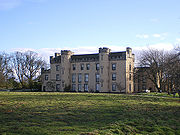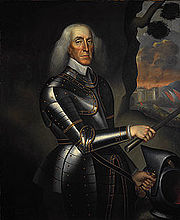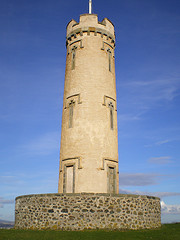
House of the Binns
Encyclopedia

Linlithgow
Linlithgow is a Royal Burgh in West Lothian, Scotland. An ancient town, it lies south of its two most prominent landmarks: Linlithgow Palace and Linlithgow Loch, and north of the Union Canal....
in Scotland
Scotland
Scotland is a country that is part of the United Kingdom. Occupying the northern third of the island of Great Britain, it shares a border with England to the south and is bounded by the North Sea to the east, the Atlantic Ocean to the north and west, and the North Channel and Irish Sea to the...
, and seat of the Dalyell (icon) family. It dates from the early 17th Century, and is currently in the care of the National Trust for Scotland
National Trust for Scotland
The National Trust for Scotland for Places of Historic Interest or Natural Beauty, commonly known as the National Trust for Scotland describes itself as the conservation charity that protects and promotes Scotland's natural and cultural heritage for present and future generations to...
.
The estate is situated on two hills (or "Binns" / "Bens" in Celtic) from which its name is derived. It is set in 200 acre (0.809372 km²) of parkland, and the house enjoys panoramic views of Central Scotland: to the north, across the River Forth
River Forth
The River Forth , long, is the major river draining the eastern part of the central belt of Scotland.The Forth rises in Loch Ard in the Trossachs, a mountainous area some west of Stirling...
to the Highlands
Scottish Highlands
The Highlands is an historic region of Scotland. The area is sometimes referred to as the "Scottish Highlands". It was culturally distinguishable from the Lowlands from the later Middle Ages into the modern period, when Lowland Scots replaced Scottish Gaelic throughout most of the Lowlands...
, and south over the Pentland Hills
Pentland Hills
The Pentland Hills are a range of hills to the south-west of Edinburgh, Scotland. The range is around 20 miles in length, and runs south west from Edinburgh towards Biggar and the upper Clydesdale.Some of the peaks include:* Scald Law...
. The house contains a collection of porcelain
Porcelain
Porcelain is a ceramic material made by heating raw materials, generally including clay in the form of kaolin, in a kiln to temperatures between and...
, furniture, and portraits tracing the family's lives and interests through the centuries.
History of the Estate
Perhaps inhabited since prehistoric timesPrehistory
Prehistory is the span of time before recorded history. Prehistory can refer to the period of human existence before the availability of those written records with which recorded history begins. More broadly, it refers to all the time preceding human existence and the invention of writing...
, Binns Hill may have been the site of a Pictish
Picts
The Picts were a group of Late Iron Age and Early Mediaeval people living in what is now eastern and northern Scotland. There is an association with the distribution of brochs, place names beginning 'Pit-', for instance Pitlochry, and Pictish stones. They are recorded from before the Roman conquest...
fort. Written records begin in 1335, and record a land of the "Bynnis". There was certainly a manor house
Manor house
A manor house is a country house that historically formed the administrative centre of a manor, the lowest unit of territorial organisation in the feudal system in Europe. The term is applied to country houses that belonged to the gentry and other grand stately homes...
here by 1478, when records indicate the owner was an Archibald Meldrum, son of the late James Meldrum of the Bynnis. In 1599, it was owned by James, Lord Lyndsay, who sold it to Sir William Livingston of Kilsyth. Then in 1612, estate was purchased by a wealthy and well-connected Edinburgh burgess, Thomas Dalyell. Dalyell was a butter merchant, who had become prosperous importing from Orkney to Leith
Leith
-South Leith v. North Leith:Up until the late 16th century Leith , comprised two separate towns on either side of the river....
(to be sold as axle grease
Grease (lubricant)
The term grease is used to describe semisolid lubricants. Although the word grease is also used to describe rendered fat of animals, in the context of lubrication, grease typically applies to a material consisting of a soap emulsified with mineral or vegetable oil...
). In 1601, he had married the daughter of Lord Kinloss
Edward Bruce, 1st Lord Kinloss
Edward Bruce, 1st Lord Kinloss PC was an Anglo-Scottish lawyer and judge.Kinloss was the second son of Edward Bruce of Blairhall and Alison Reid. He served as a Lord of Session from 1597 to 1603 and was created Lord Kinloss in 1602, with remainder to his heirs and assigns whatsoever...
and, when the Scots King James VI
James I of England
James VI and I was King of Scots as James VI from 24 July 1567 and King of England and Ireland as James I from the union of the English and Scottish crowns on 24 March 1603...
ascended to the English Throne and Kinloss was made his Master of the Rolls
Master of the Rolls
The Keeper or Master of the Rolls and Records of the Chancery of England, known as the Master of the Rolls, is the second most senior judge in England and Wales, after the Lord Chief Justice. The Master of the Rolls is the presiding officer of the Civil Division of the Court of Appeal...
in London, Dalyell obtained the lucrative post of deputy. In that senior position, he acquired enough of a fortune to return to Scotland and join the landed gentry
Landed gentry
Landed gentry is a traditional British social class, consisting of land owners who could live entirely off rental income. Often they worked only in an administrative capacity looking after the management of their own lands....
. He bought "the lands of Bynnis and Croceflattis wirth the manor place thereof", and the Dalyell family have lived there ever since. Between 1621 and 1630, this Thomas Dalyell rebuilt the original house, and parts of the interior still reflect that period; in particular the north-west portion of the present entrance front, and decoration of the High Hall and King's Room (created in the hope of a visit from Charles I
Charles I of England
Charles I was King of England, King of Scotland, and King of Ireland from 27 March 1625 until his execution in 1649. Charles engaged in a struggle for power with the Parliament of England, attempting to obtain royal revenue whilst Parliament sought to curb his Royal prerogative which Charles...
, which never came to be). These rooms still contain examples of some of the earliest cornices and mouldings in Scotland. Thomas Dalyell's more famous son, the Royalist General Tam Dalyell of the Binns continued the development of the house, adding the first of the towers, and the western range.
However, today the house principally reflects extensions of the mid 18th and early 19th century. In the 1740s, Robert Dalyell added the dining-room and a morning room, whilst around 1810, the architect William Burn
William Burn
William Burn was a Scottish architect, pioneer of the Scottish Baronial style.He was born in Edinburgh, the son of architect Robert Burn, and educated at the Royal High School. After training with the architect of the British Museum, Sir Robert Smirke, he returned to Edinburgh in 1812...
(1789–1870) adapted the building to the Scottish baronial style
Scottish baronial style
The Scottish Baronial style is part of the Gothic Revival architecture style, using stylistic elements and forms from castles, tower houses and mansions of the Gothic architecture period in Scotland, such as Craigievar Castle and Newark Castle, Port Glasgow. The revival style was popular from the...
, adding further towers and mock battlements. Some of the Gothic
Gothic architecture
Gothic architecture is a style of architecture that flourished during the high and late medieval period. It evolved from Romanesque architecture and was succeeded by Renaissance architecture....
exterior decoration was inspired by Walter Scott
Walter Scott
Sir Walter Scott, 1st Baronet was a Scottish historical novelist, playwright, and poet, popular throughout much of the world during his time....
, who was a friend of the Dalyell family. Today, the building is three-storey at the main north facade, with two-storey wings.
In 1944, the house, its parkland, its contents, and an endowment for its upkeep were given to the National Trust for Scotland
National Trust for Scotland
The National Trust for Scotland for Places of Historic Interest or Natural Beauty, commonly known as the National Trust for Scotland describes itself as the conservation charity that protects and promotes Scotland's natural and cultural heritage for present and future generations to...
by Eleanor Dalyell. The charter she granted states that the "history, legend and memory of the family of Dalyell of The Binns, shall be preserved..." for the benefit and enjoyment of the nation. However, the right of the family to reside in the house was retained. Today, the former MP for Linlithgow, and "Father of the House", Sir Tam Dalyell
Tam Dalyell
Sir Thomas Dalyell Loch, 11th Baronet , known as Tam Dalyell, is a British Labour Party politician, who was a Member of Parliament in the House of Commons from 1962 to 2005, first for West Lothian and then for Linlithgow.-Early life:...
(b.1932) still lives in the western range of the house. His full title being "Sir Thomas Dalyell of the Binns, 11th Baronet". His wife, Kathleen Dalyell, is the National Trust's representative for the House of the Binns and heavily involved in its maintenance.
General Tam o' the Binns

Charles I of England
Charles I was King of England, King of Scotland, and King of Ireland from 27 March 1625 until his execution in 1649. Charles engaged in a struggle for power with the Parliament of England, attempting to obtain royal revenue whilst Parliament sought to curb his Royal prerogative which Charles...
and Charles II
Charles II of England
Charles II was monarch of the three kingdoms of England, Scotland, and Ireland.Charles II's father, King Charles I, was executed at Whitehall on 30 January 1649, at the climax of the English Civil War...
. During the Civil War
English Civil War
The English Civil War was a series of armed conflicts and political machinations between Parliamentarians and Royalists...
, he was taken prisoner by the parliamentarians at the battle of Worcester
Battle of Worcester
The Battle of Worcester took place on 3 September 1651 at Worcester, England and was the final battle of the English Civil War. Oliver Cromwell and the Parliamentarians defeated the Royalist, predominantly Scottish, forces of King Charles II...
and imprisoned in the Tower of London
Tower of London
Her Majesty's Royal Palace and Fortress, more commonly known as the Tower of London, is a historic castle on the north bank of the River Thames in central London, England. It lies within the London Borough of Tower Hamlets, separated from the eastern edge of the City of London by the open space...
. However, he escaped and travelled to Russia
Russia
Russia or , officially known as both Russia and the Russian Federation , is a country in northern Eurasia. It is a federal semi-presidential republic, comprising 83 federal subjects...
where he fought for the Tsar — earning the epithet "Muscovite De'il". He returned to Scotland at the Restoration
English Restoration
The Restoration of the English monarchy began in 1660 when the English, Scottish and Irish monarchies were all restored under Charles II after the Interregnum that followed the Wars of the Three Kingdoms...
of the king, and secured his feared reputation (as "Bluidy Tam") by his violent suppression of the Covenanter
Covenanter
The Covenanters were a Scottish Presbyterian movement that played an important part in the history of Scotland, and to a lesser extent in that of England and Ireland, during the 17th century...
s from the 1660s. In 1678, he became Commander-in-Chief in Scotland and, in 1681, he mustered a new regiment at the Binns, becoming its first colonel
Colonel
Colonel , abbreviated Col or COL, is a military rank of a senior commissioned officer. It or a corresponding rank exists in most armies and in many air forces; the naval equivalent rank is generally "Captain". It is also used in some police forces and other paramilitary rank structures...
. That Regiment, the Royal Regiment of Scots Dragoons, which later became the Royal Scots Greys in 1877, was to have itself a long history. Many artefacts belonging to General Dalyell (including his boots) are still located at the Binns. Some are connected with the fairly dubious stories that have grown up around him. In this house, the General is said to have played cards with the Devil: and today, in the entrance (or Laigh) hall, the very table on which he is supposed to have played can still be seen. The story goes that, although the devil normally beat Tam, one night Tam won, and in fury the Devil threw a marble table at him. However, it missed and it landed in the Sergeants' Pond outside. A marble table was indeed found when the pond dried up 200 years later. The cards, goblet and spoon, supposedly used in the game are displayed in the house. The General is said to have told the Devil, who threatened to blow down his house and its walls, that "I will build me a turret at every corner to pin down my walls".
The Parkland

In addition to the folly, the park contains a number of other important features. Off the west drive is a derelict stables and a walled garden
Walled garden
A walled garden is specifically a garden enclosed by high walls for horticultural rather than security purposes, though traditionally all gardens have been hedged about or walled for protection from animal or human intruders...
. The walled garden, constructed at an unknown date, served as a kitchen garden until World War II
World War II
World War II, or the Second World War , was a global conflict lasting from 1939 to 1945, involving most of the world's nations—including all of the great powers—eventually forming two opposing military alliances: the Allies and the Axis...
. It is presently used by a contractor as a tree and shrub nursery - although part is used to provide flowers for the house. Also near the west drive is the Sergeant's Pond, which was constructed as a watering place for the horses of the Royal Scots Greys by General Dalyell. In a valley in the south-east corner of the park there is a caravan park which was established in 1978 — the caravan park also includes a small woodland area.

